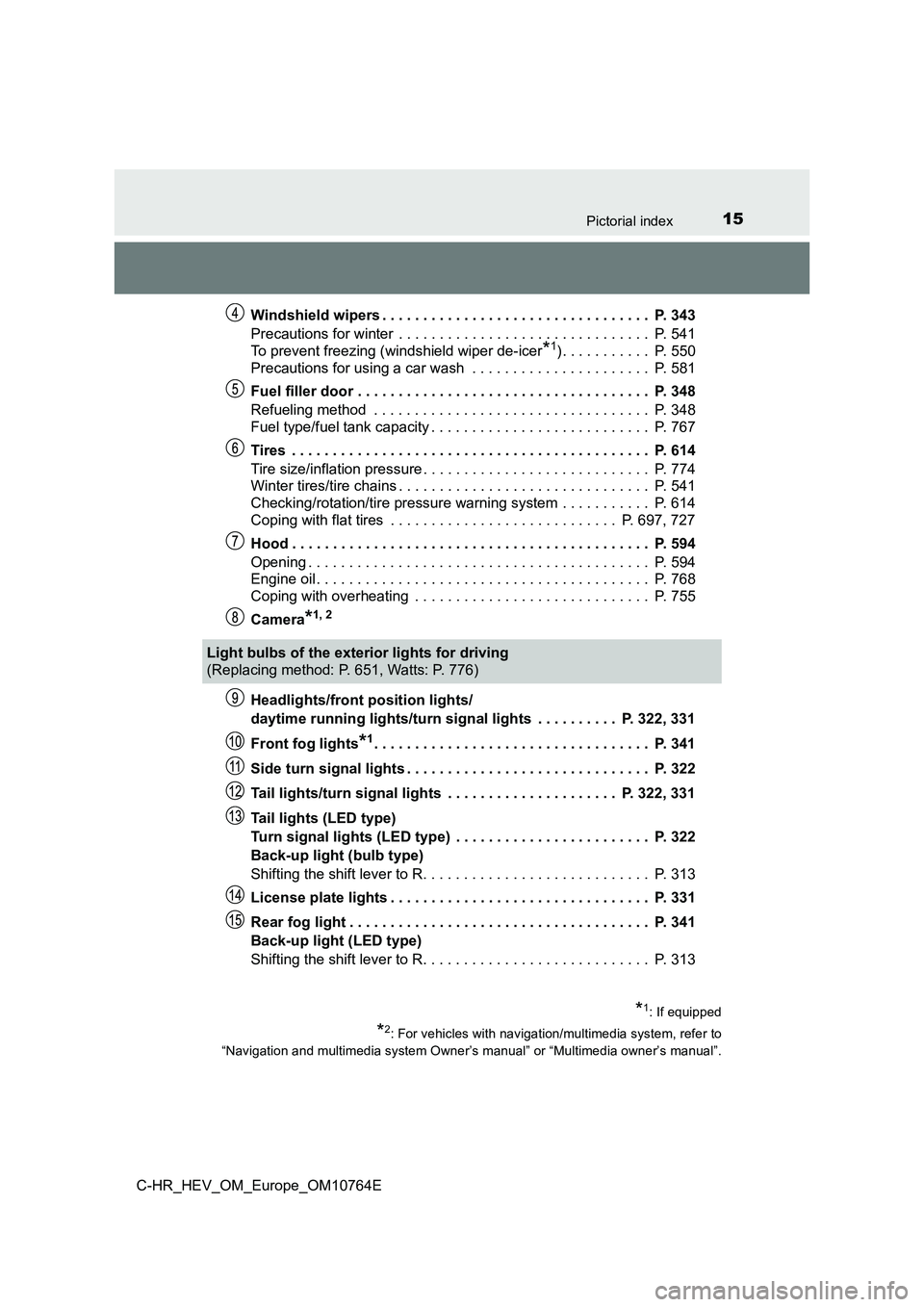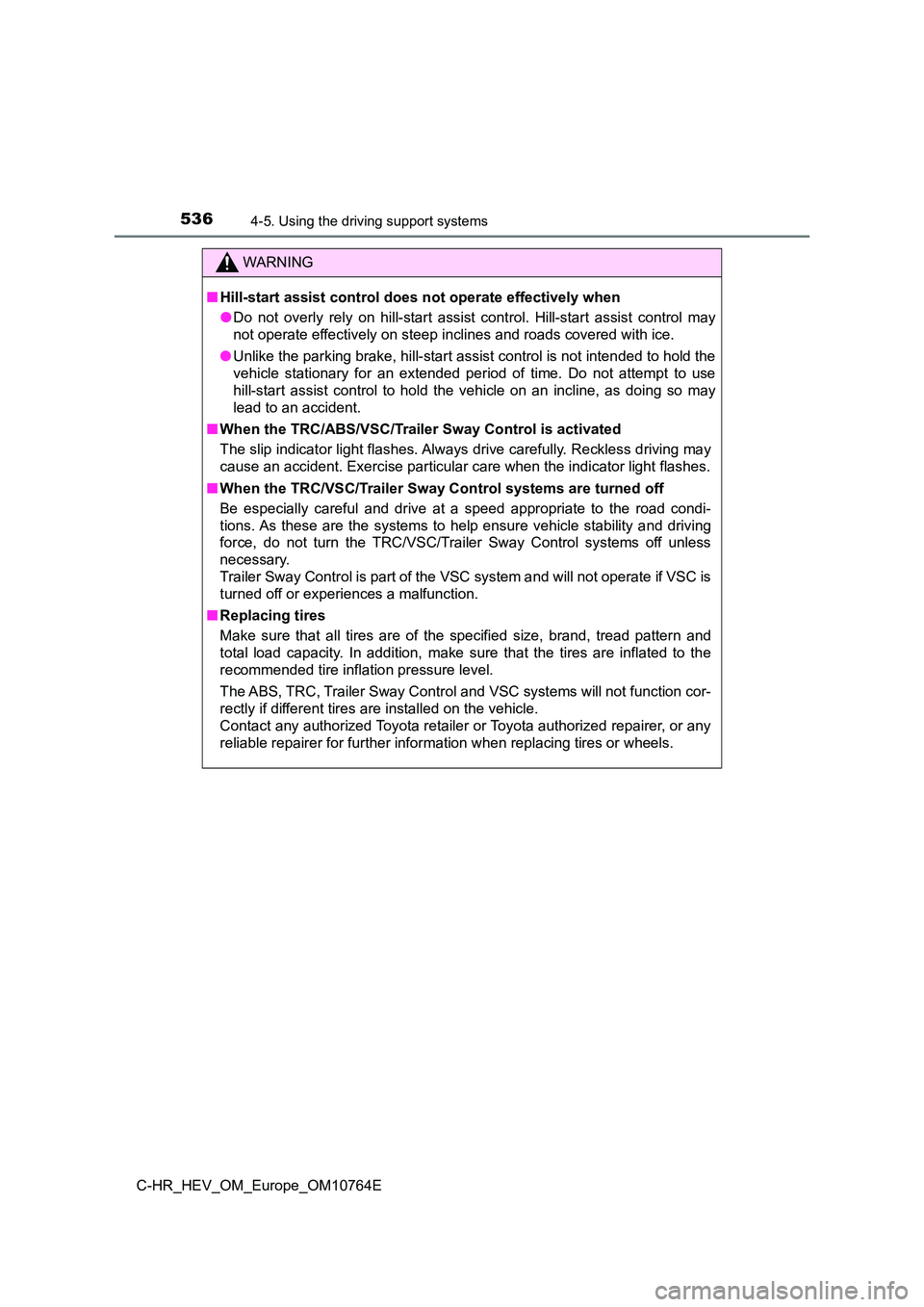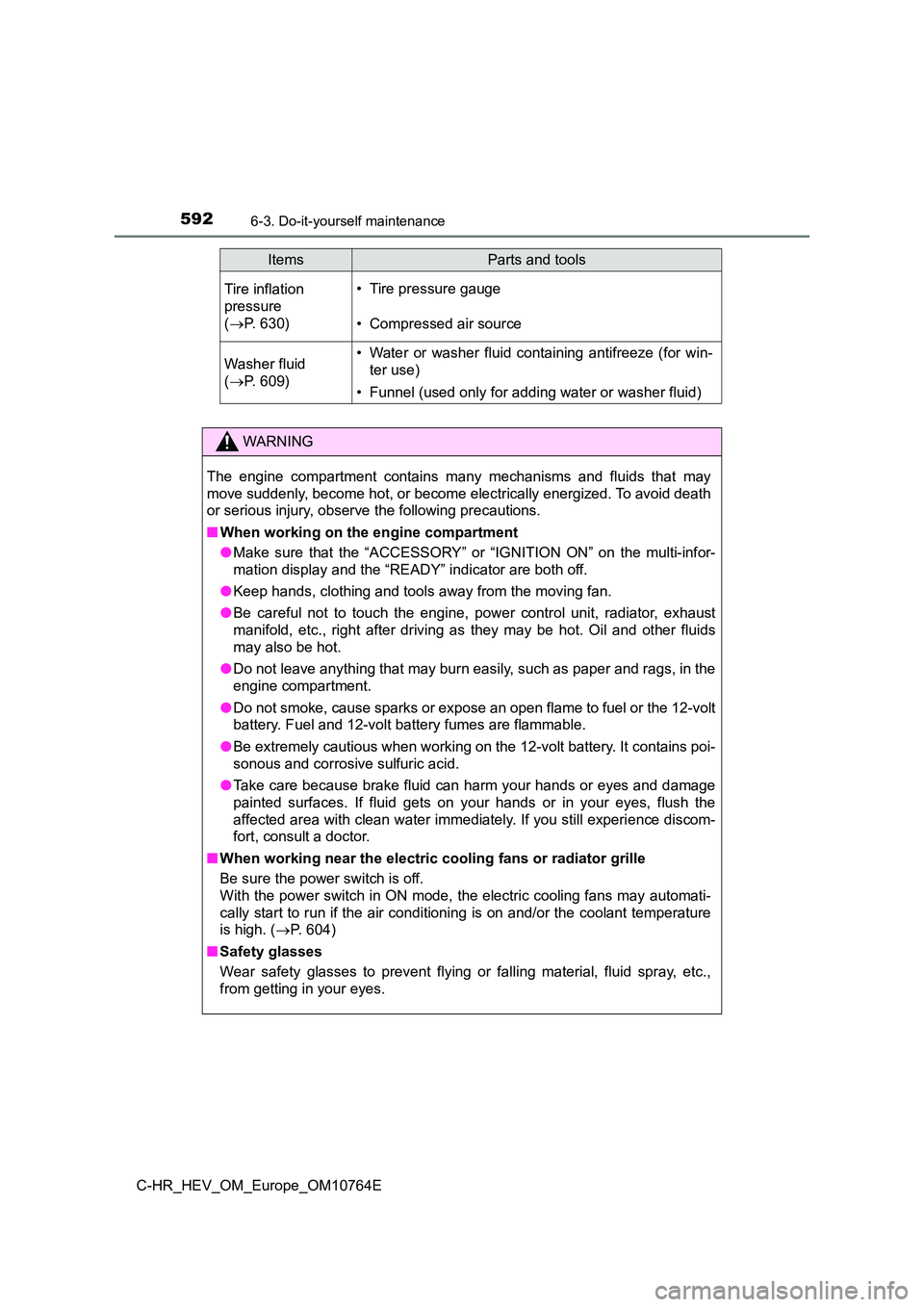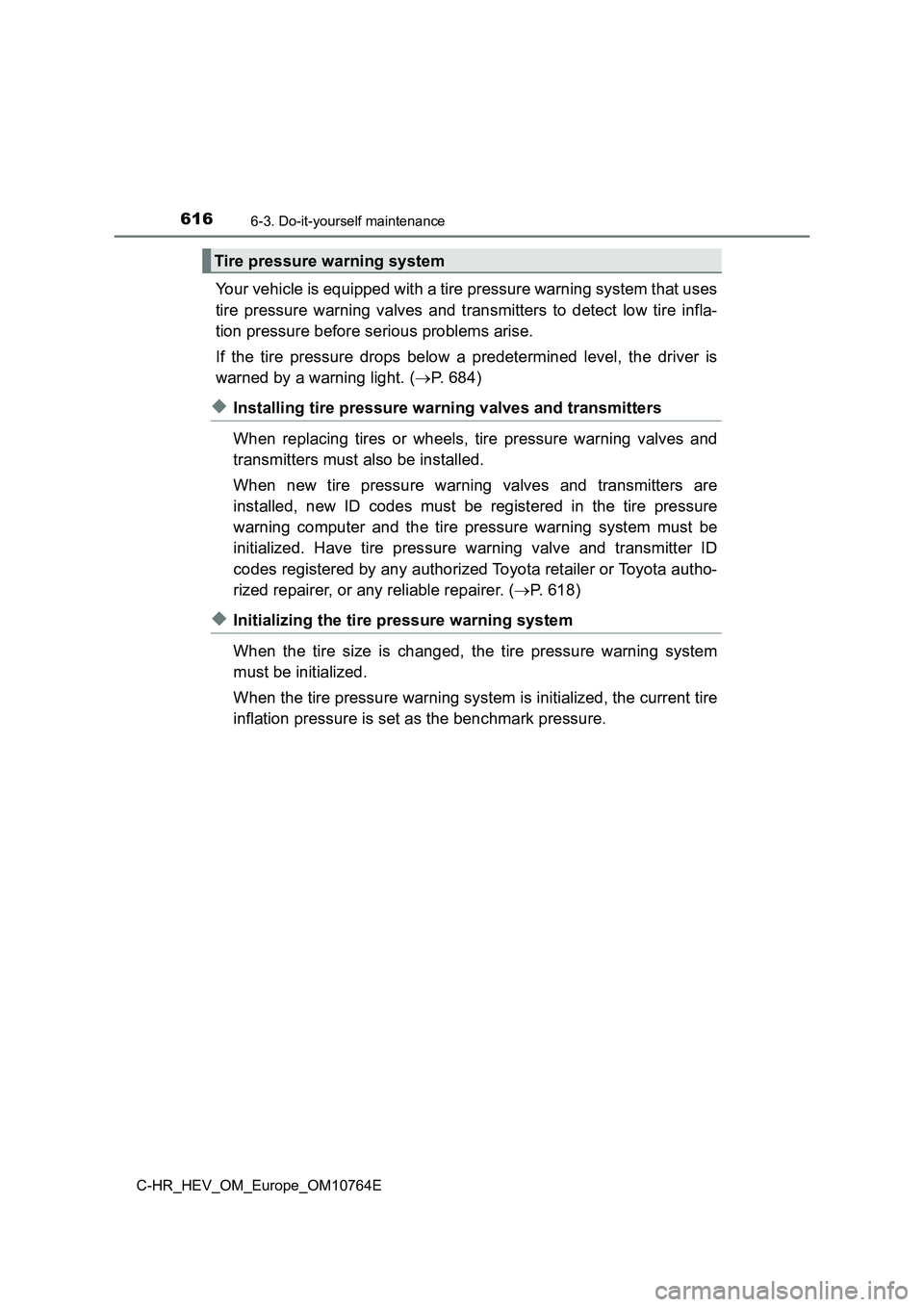inflation pressure TOYOTA C-HR 2023 Owners Manual
[x] Cancel search | Manufacturer: TOYOTA, Model Year: 2023, Model line: C-HR, Model: TOYOTA C-HR 2023Pages: 814, PDF Size: 112.62 MB
Page 7 of 814

5
1
5
4
3
2
C-HR_HEV_OM_Europe_OM10764E
8
7
6
5-1. Using the air conditioning
system and defogger
Air conditioning system ......546
Heated steering wheel/
seat heaters .....................555
5-2. Using the interior lights
Interior lights list .................557
• Interior lights ..................558
• Personal lights ...............558
5-3. Using the storage
features
List of storage features ......560
• Glove box ......................561
• Console box ..................561
• Bottle holders ................562
• Cup holders ...................563
Luggage compartment
features............................564
5-4. Using the other interior
features
Other interior features ........572
• Sun visors ......................572
• Vanity mirrors ................572
• Clock .............................573
• Power outlet ..................574
• Assist grips ....................575
6-1. Maintenance and care
Cleaning and protecting the
vehicle exterior ................ 578
Cleaning and protecting the
vehicle interior ................. 584
6-2. Maintenance
Maintenance
requirements ................... 588
6-3. Do-it-yourself
maintenance
Do-it-yourself service
precautions ..................... 591
Hood.................................. 594
Positioning a floor jack ...... 596
Engine compartment ......... 597
12-volt battery
(M20A-FXS engine) ........ 610
Tires .................................. 614
Tire inflation pressure........ 630
Wheels .............................. 632
Air conditioning filter .......... 635
Hybrid battery
(traction battery)
air intake vent and filter ... 638
Electronic key battery ........ 643
Checking and replacing
fuses ............................... 646
Light bulbs ......................... 651
5Interior features6Maintenance and care
Page 17 of 814

15Pictorial index
C-HR_HEV_OM_Europe_OM10764E
Windshield wipers . . . . . . . . . . . . . . . . . . . . . . . . . . . . . . . . . P. 343
Precautions for winter . . . . . . . . . . . . . . . . . . . . . . . . . . . . . . . P. 541
To prevent freezing (windshield wiper de-icer*1) . . . . . . . . . . . P. 550
Precautions for using a car wash . . . . . . . . . . . . . . . . . . . . . . P. 581
Fuel filler door . . . . . . . . . . . . . . . . . . . . . . . . . . . . . . . . . . . . P. 348
Refueling method . . . . . . . . . . . . . . . . . . . . . . . . . . . . . . . . . . P. 348
Fuel type/fuel tank capacity . . . . . . . . . . . . . . . . . . . . . . . . . . . P. 767
Tires . . . . . . . . . . . . . . . . . . . . . . . . . . . . . . . . . . . . . . . . . . . . P. 614
Tire size/inflation pressure . . . . . . . . . . . . . . . . . . . . . . . . . . . . P. 774
Winter tires/tire chains . . . . . . . . . . . . . . . . . . . . . . . . . . . . . . . P. 541
Checking/rotation/tire pressure warning system . . . . . . . . . . . P. 614
Coping with flat tires . . . . . . . . . . . . . . . . . . . . . . . . . . . . P. 697, 727
Hood . . . . . . . . . . . . . . . . . . . . . . . . . . . . . . . . . . . . . . . . . . . . P. 594
Opening . . . . . . . . . . . . . . . . . . . . . . . . . . . . . . . . . . . . . . . . . . P. 594
Engine oil . . . . . . . . . . . . . . . . . . . . . . . . . . . . . . . . . . . . . . . . . P. 768
Coping with overheating . . . . . . . . . . . . . . . . . . . . . . . . . . . . . P. 755
Camera*1, 2
Headlights/front position lights/
daytime running lights/turn sig nal lights . . . . . . . . . . P. 322, 331
Front fog lights*1. . . . . . . . . . . . . . . . . . . . . . . . . . . . . . . . . . P. 341
Side turn signal lights . . . . . . . . . . . . . . . . . . . . . . . . . . . . . . P. 322
Tail lights/turn signal lights . . . . . . . . . . . . . . . . . . . . . P. 322, 331
Tail lights (LED type)
Turn signal lights (LED type) . . . . . . . . . . . . . . . . . . . . . . . . P. 322
Back-up light (bulb type)
Shifting the shift lever to R. . . . . . . . . . . . . . . . . . . . . . . . . . . . P. 313
License plate lights . . . . . . . . . . . . . . . . . . . . . . . . . . . . . . . . P. 331
Rear fog light . . . . . . . . . . . . . . . . . . . . . . . . . . . . . . . . . . . . . P. 341
Back-up light (LED type)
Shifting the shift lever to R. . . . . . . . . . . . . . . . . . . . . . . . . . . . P. 313
Light bulbs of the exterior lights for driving
(Replacing method: P. 651, Watts: P. 776)
*1: If equipped
*2: For vehicles with navigation/multimedia system, refer to
“Navigation and multimedia system Owner’s manual” or “Multimedi a owner’s manual”.
Page 298 of 814

2964-1. Before driving
C-HR_HEV_OM_Europe_OM10764E
■Information tag (manufacturer’s label)
Gross vehicle mass
The combined weight of the driver, passengers, luggage, towing hitch,
total curb mass and drawbar load should not exceed the gross ve hicle
mass by more than 100 kg (220.5 lb.). Exceeding this weight is danger-
ous.
Maximum permissible rear axle capacity
The weight borne by the rear axle should not exceed the maximum per-
missible rear axle capacity by 15% or more. Exceeding this weig ht is
dangerous.
The values for towing capacity were derived from testing conduc ted at
sea level. Take note that engine output and towing capacity wil l be
reduced at high altitudes.
Ty pe AType B
WARNING
■ When the gross vehicle mass or maximum permissible axle capacity is
exceeded
Failing to observe this precaution may lead to an accident caus ing death or
serious injury.
● Add an additional 20.0 kPa (0.2 kgf/cm2 or bar, 3 psi) to the recommended
tire inflation pressure value. ( P. 774)
● Do not exceed the established speed limit for towing a trailer in built-up
areas or 100 km/h (62 mph), whichever is the lower.
Page 300 of 814

2984-1. Before driving
C-HR_HEV_OM_Europe_OM10764E
■Tire information
● Increase the tire inflation pressure to 20.0 kPa (0.2 kgf/cm2 or bar, 3 psi)
greater than the recommended value when towing. ( P. 774)
● Increase the air pressure of the trailer tires in accordance with the total
trailer weight and according to the values recommended by the m anufac-
turer of your trailer.
■ Trailer lights
Please consult at any authorized retailer or Toyota authorized repairer, or any
reliable repairer when installing trailer lights, as incorrect installation may
cause damage to the vehicle’s lights. Please take care to compl y with your
state’s laws when installing trailer lights.
■ Break-in schedule
Toyota recommends that vehicles fitted with new power train com ponents
should not be used for towing trailers for the first 800 km (50 0 miles).
■ Safety checks before towing
● Check that the maximum load limit for the towing hitch/bracket and hitch ball
is not exceeded. Bear in mind that the coupling weight of the t railer will add
to the load exerted on the vehicle. Also make sure that the tot al load exerted
on the vehicle is within the range of the weight limits. ( P. 295)
● Ensure that the trailer load is secure.
● Supplementary outside rear view mirrors should be added to the vehicle if
the traffic behind cannot be clearly seen with standard mirrors . Adjust the
extending arms of these mirrors on both sides of the vehicle so that they
always provide maximum visibility of the road behind.
■ Maintenance
● Maintenance must be performed more frequently when using the vehicle for
towing due to the greater weight burden placed on the vehicle c ompared to
normal driving.
● Retighten all bolts securing the hitching ball and bracket after towing for
approximately 1000 km (600 miles).
Page 386 of 814

3844-5. Using the driving support systems
C-HR_HEV_OM_Europe_OM10764E
● For region A: In addition to the above, in some situations, such as the fol-
lowing, the emergency steering assist may not operate.
• For region A: When the white (yellow) lane lines are difficult to see, such
as when they are faint, diverging/merging, or a shadow is cast upon them
• For region A: When the lane is wider or narrower than normal
• For region A: When there is a light and dark pattern on the ro ad surface,
such as due to road repairs
• For region A: When a pedestrian is detected near the centerlin e of the
vehicle
• For region A: When the target is too close
• For region A: When there is insufficient safe or unobstructed space for
the vehicle to be steered into
• For region A: If oncoming vehicle is present
• For region A: If VSC function is operating
● In some situations such as the following, sufficient braking force or steering
force (for region A) may not be obtained, preventing the system from per-
forming properly:
• If the braking functions cannot operate to their full extent, such as when
the brake parts are extremely cold, extremely hot, or wet
• If the vehicle is not properly maintained (brakes or tires are excessively
worn, improper tire inflation pressure, etc.)
• When the vehicle is being driven on a gravel road or other sli ppery sur-
face
• When the road surface has deep wheel tracks
• When driving on a hill road
• When driving on a road that has inclines to the left or right
■ If VSC is disabled
● If VSC is disabled (P. 533), the pre-collision brake assist and pre-collision
braking functions are also disabled.
● The PCS warning light will turn on and “VSC Turned Off. Pre-Collision Brake
System Unavailable.” will be displayed on the multi-information display.
Page 538 of 814

5364-5. Using the driving support systems
C-HR_HEV_OM_Europe_OM10764E
WARNING
■Hill-start assist control does not operate effectively when
● Do not overly rely on hill-start assist control. Hill-start assist control may
not operate effectively on steep inclines and roads covered wit h ice.
● Unlike the parking brake, hill-start assist control is not intended to hold the
vehicle stationary for an extended period of time. Do not attem pt to use
hill-start assist control to hold the vehicle on an incline, as doing so may
lead to an accident.
■ When the TRC/ABS/VSC/Trailer Sway Control is activated
The slip indicator light flashes. Always drive carefully. Reckl ess driving may
cause an accident. Exercise particular care when the indicator light flashes.
■ When the TRC/VSC/Trailer Sway Control systems are turned off
Be especially careful and drive at a speed appropriate to the r oad condi-
tions. As these are the systems to help ensure vehicle stabilit y and driving
force, do not turn the TRC/VSC/Trailer Sway Control systems off unless
necessary.
Trailer Sway Control is part of the VSC system and will not ope rate if VSC is
turned off or experiences a malfunction.
■ Replacing tires
Make sure that all tires are of the specified size, brand, trea d pattern and
total load capacity. In addition, make sure that the tires are inflated to the
recommended tire inflation pressure level.
The ABS, TRC, Trailer Sway Control and VSC systems will not fun ction cor-
rectly if different tires are installed on the vehicle.
Contact any authorized Toyota retailer or Toyota authorized rep airer, or any
reliable repairer for further information when replacing tires or wheels.
Page 542 of 814

5404-6. Driving tips
C-HR_HEV_OM_Europe_OM10764E
◆Checking tire inflation pressure
Make sure to check the tire inflation pressure frequently. Impr oper
tire inflation pressure can cause poor fuel economy.
Also, as snow tires can cause large amounts of friction, their use on
dry roads can lead to poor fuel economy. Use tires that are app ro-
priate for the season.
◆Luggage
Carrying heavy luggage will lead to poor fuel economy. Avoid ca rry-
ing unnecessary luggage. Installing a large roof rack will also cause
poor fuel economy.
◆Warming up before driving
Since the gasoline engine starts up and cuts out automatically
when cold, warming up the engine is unnecessary. Moreover, fre-
quently driving short distances will cause the engine to repeat edly
warm up, which can lead to excess fuel consumption.
Page 579 of 814

577
6Maintenance and care
C-HR_HEV_OM_Europe_OM10764E
6-1. Maintenance and care
Cleaning and protecting the
vehicle exterior ................ 578
Cleaning and protecting the
vehicle interior ................. 584
6-2. Maintenance
Maintenance
requirements.................... 588
6-3. Do-it-yourself
maintenance
Do-it-yourself service
precautions ...................... 591
Hood .................................. 594
Positioning a floor jack ....... 596
Engine compartment.......... 597
12-volt battery
(M20A-FXS engine) ......... 610
Tires ................................... 614
Tire inflation pressure ........ 630
Wheels ............................... 632
Air conditioning filter .......... 635
Hybrid battery
(traction battery) air intake
vent and filter ................... 638
Electronic key battery ........ 643
Checking and replacing
fuses ................................ 646
Light bulbs ......................... 651
Page 594 of 814

5926-3. Do-it-yourself maintenance
C-HR_HEV_OM_Europe_OM10764E
Tire inflation
pressure
( P. 630)
• Tire pressure gauge
• Compressed air source
Washer fluid
( P. 609)
• Water or washer fluid containing antifreeze (for win-
ter use)
• Funnel (used only for adding water or washer fluid)
WARNING
The engine compartment contains many mechanisms and fluids that may
move suddenly, become hot, or become electrically energized. To avoid death
or serious injury, observe the following precautions.
■ When working on the engine compartment
● Make sure that the “ACCESSORY” or “IGNITION ON” on the multi-infor-
mation display and the “READY” indicator are both off.
● Keep hands, clothing and tools away from the moving fan.
● Be careful not to touch the engine, power control unit, radiator, exhaust
manifold, etc., right after driving as they may be hot. Oil and other fluids
may also be hot.
● Do not leave anything that may burn easily, such as paper and rags, in the
engine compartment.
● Do not smoke, cause sparks or expose an open flame to fuel or the 12-volt
battery. Fuel and 12-volt battery fumes are flammable.
● Be extremely cautious when working on the 12-volt battery. It contains poi-
sonous and corrosive sulfuric acid.
● Take care because brake fluid can harm your hands or eyes and damage
painted surfaces. If fluid gets on your hands or in your eyes, flush the
affected area with clean water immediately. If you still experi ence discom-
fort, consult a doctor.
■ When working near the electric cooling fans or radiator grille
Be sure the power switch is off.
With the power switch in ON mode, the electric cooling fans may automati-
cally start to run if the air conditioning is on and/or the coo lant temperature
is high. ( P. 604)
■ Safety glasses
Wear safety glasses to prevent flying or falling material, flui d spray, etc.,
from getting in your eyes.
ItemsParts and tools
Page 618 of 814

6166-3. Do-it-yourself maintenance
C-HR_HEV_OM_Europe_OM10764E
Your vehicle is equipped with a tire pressure warning system that uses
tire pressure warning valves and transmitters to detect low tir e infla-
tion pressure before serious problems arise.
If the tire pressure drops below a predetermined level, the dri ver is
warned by a warning light. ( P. 684)
◆Installing tire pressure warning valves and transmitters
When replacing tires or wheels, tire pressure warning valves an d
transmitters must also be installed.
When new tire pressure warning valves and transmitters are
installed, new ID codes must be registered in the tire pressure
warning computer and the tire pressure warning system must be
initialized. Have tire pressure warning valve and transmitter I D
codes registered by any authorized Toyota retailer or Toyota au tho-
rized repairer, or any reliable repairer. ( P. 618)
◆Initializing the tire pressure warning system
When the tire size is changed, the tire pressure warning system
must be initialized.
When the tire pressure warning system is initialized, the curre nt tire
inflation pressure is set as the benchmark pressure.
Tire pressure warning system